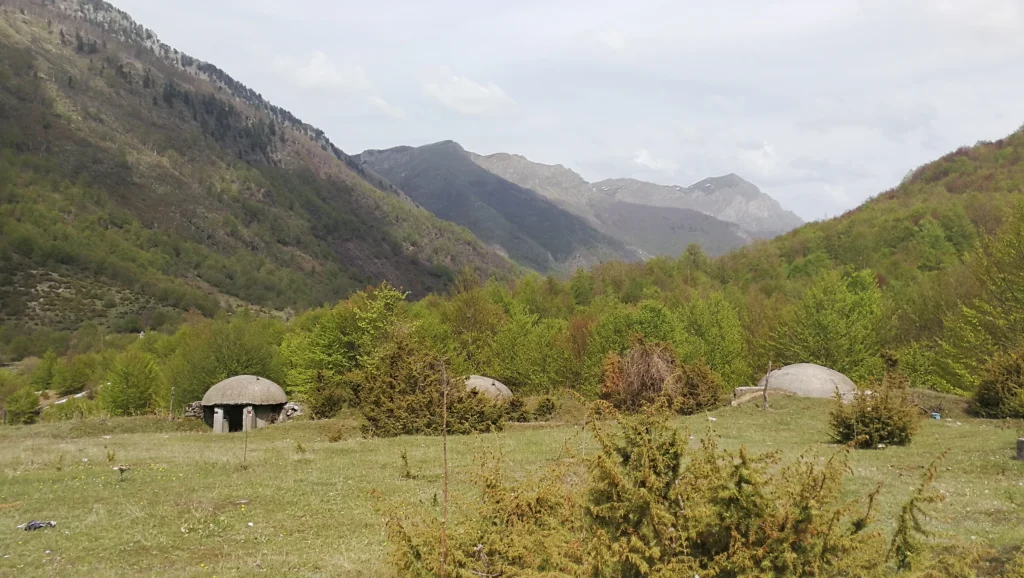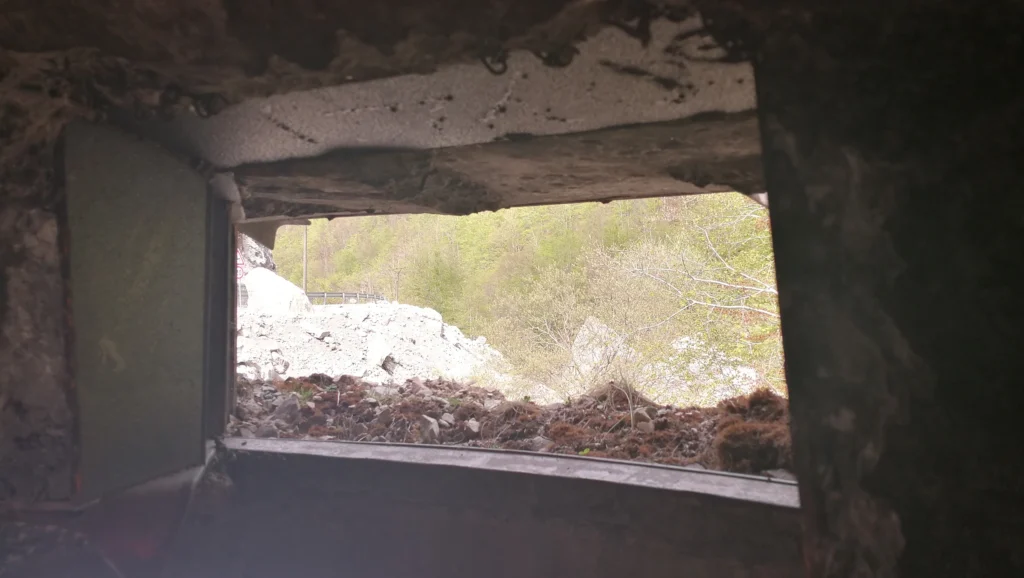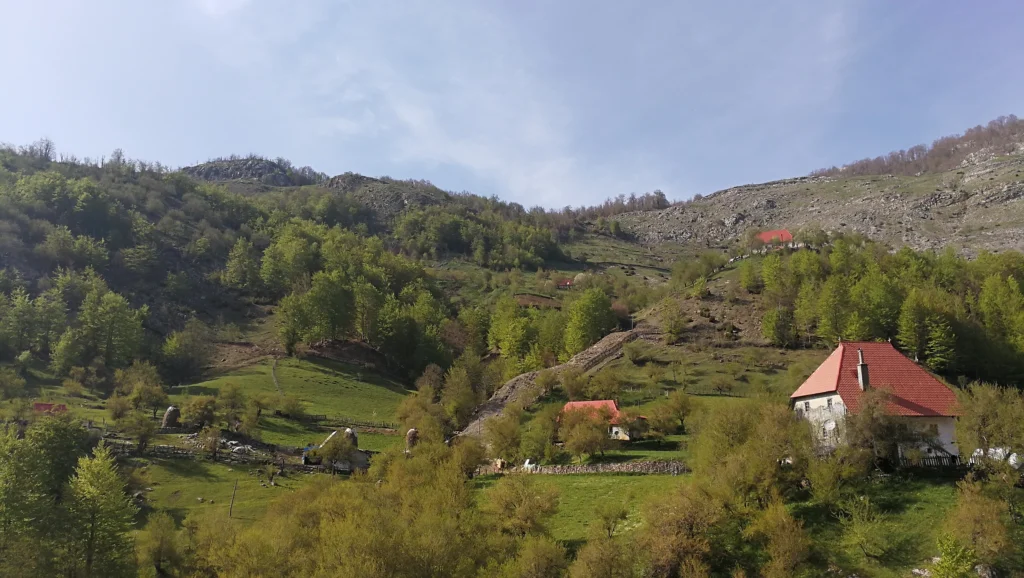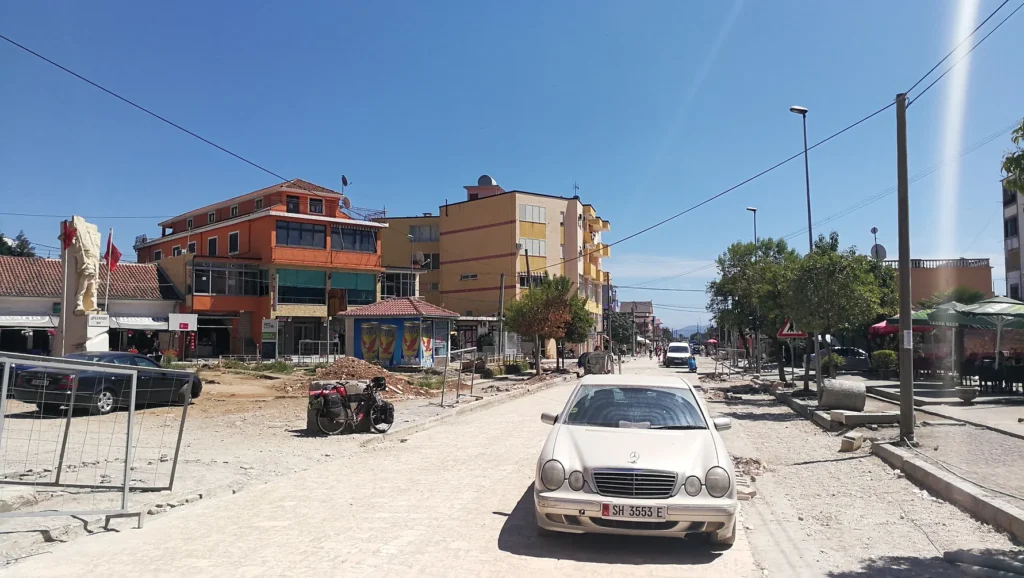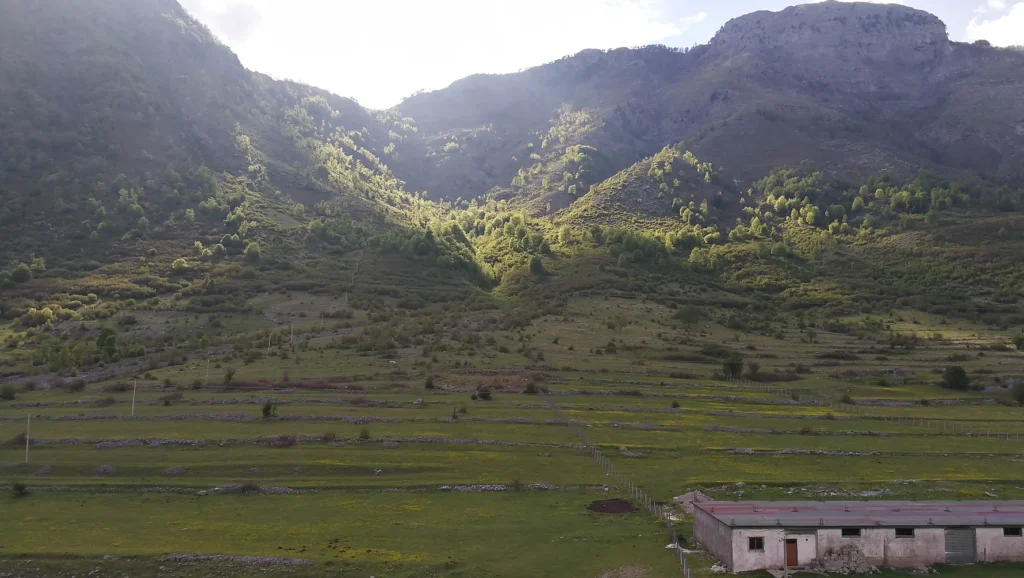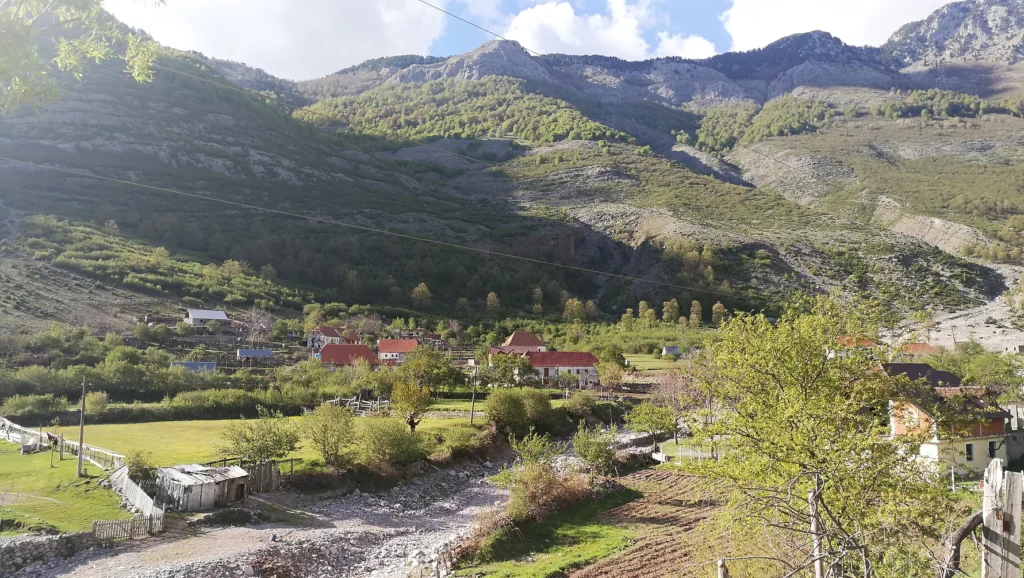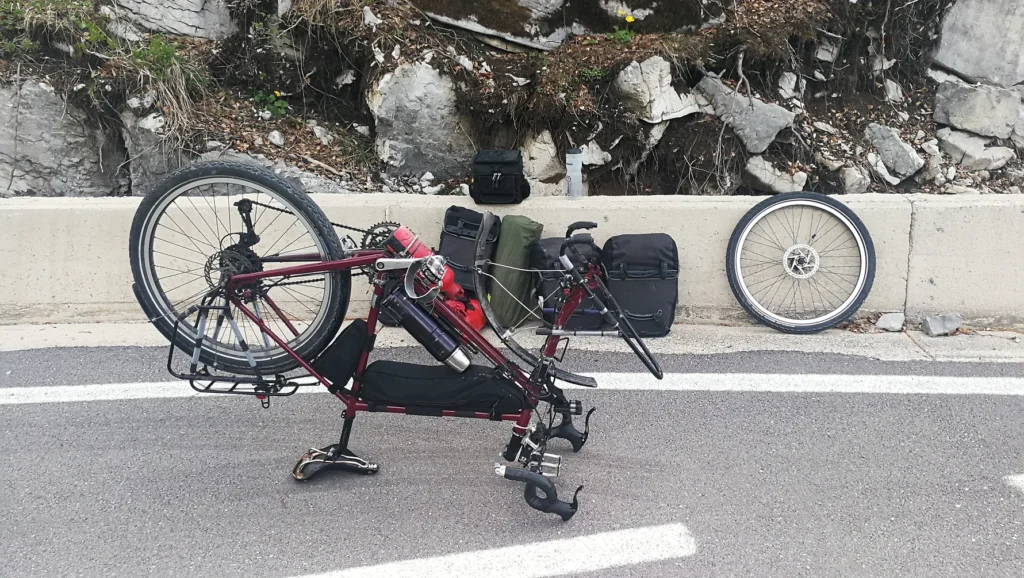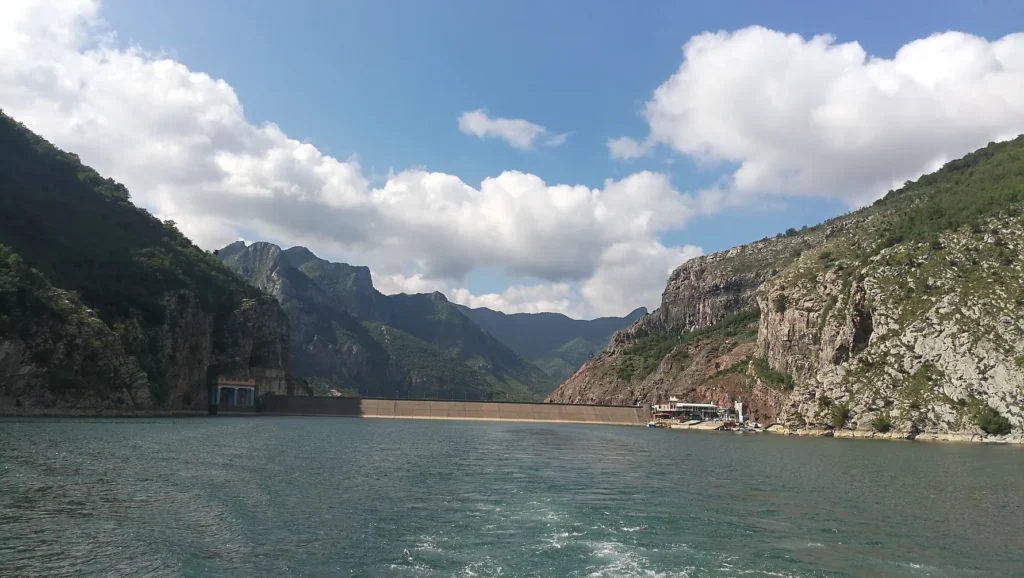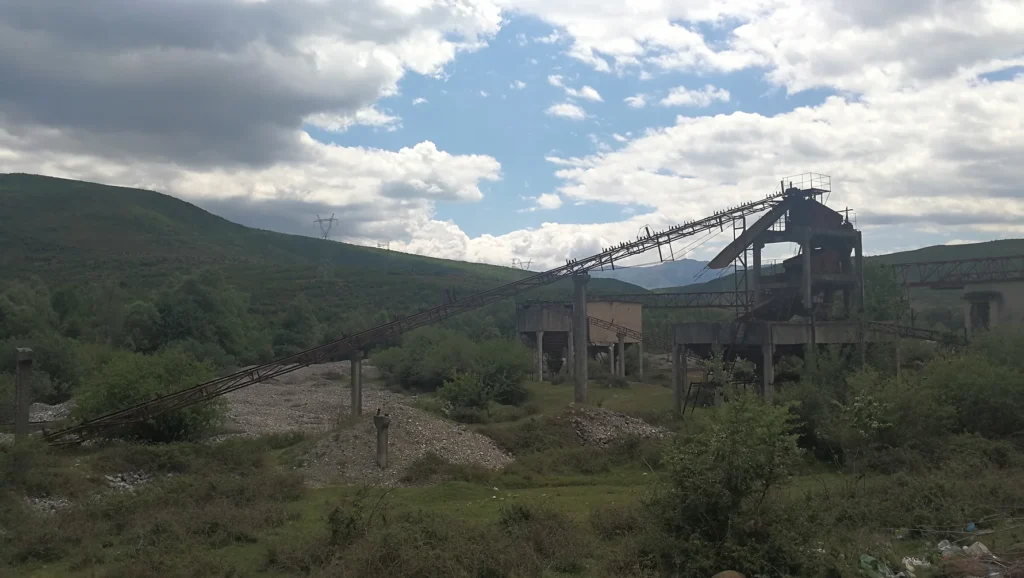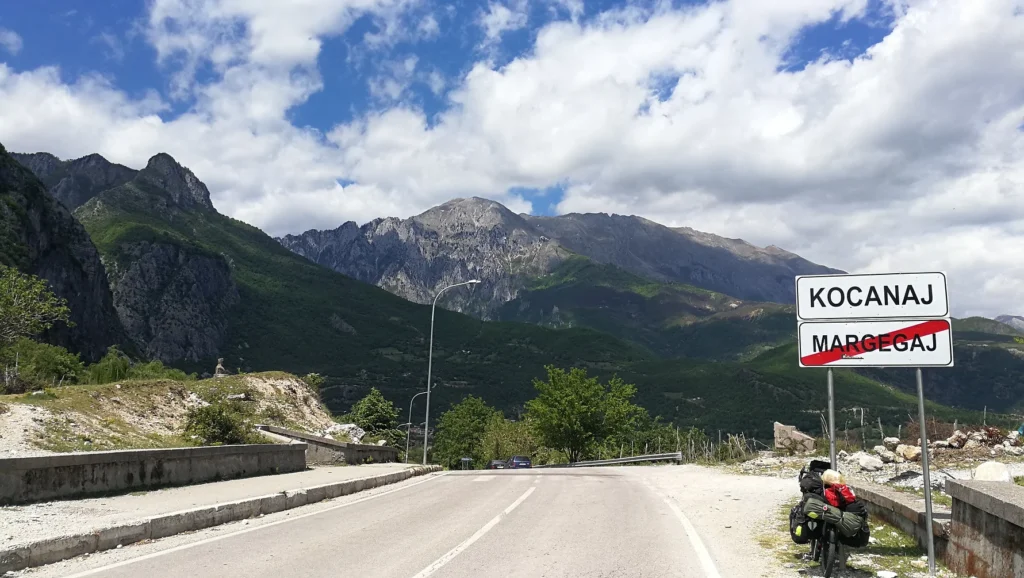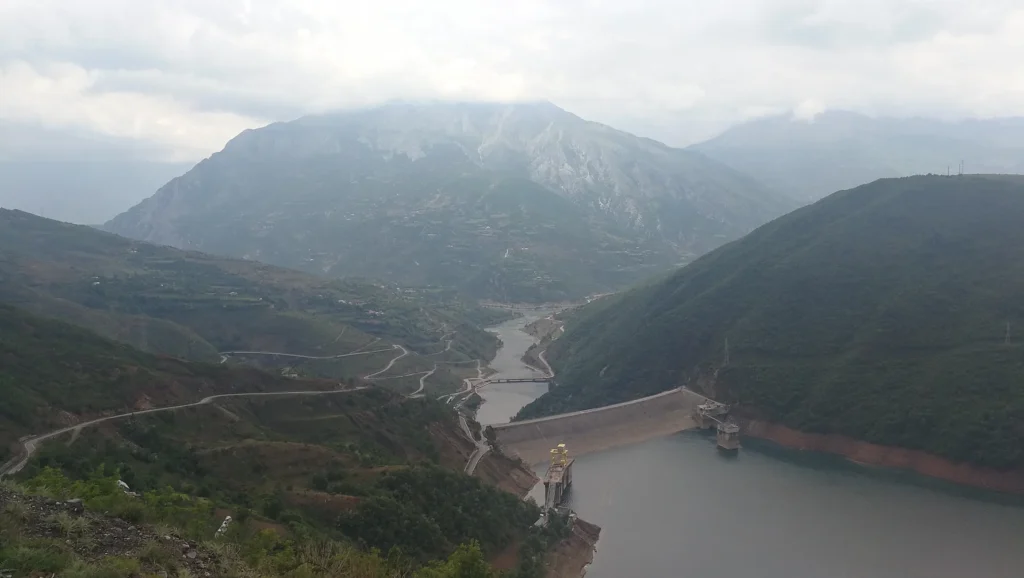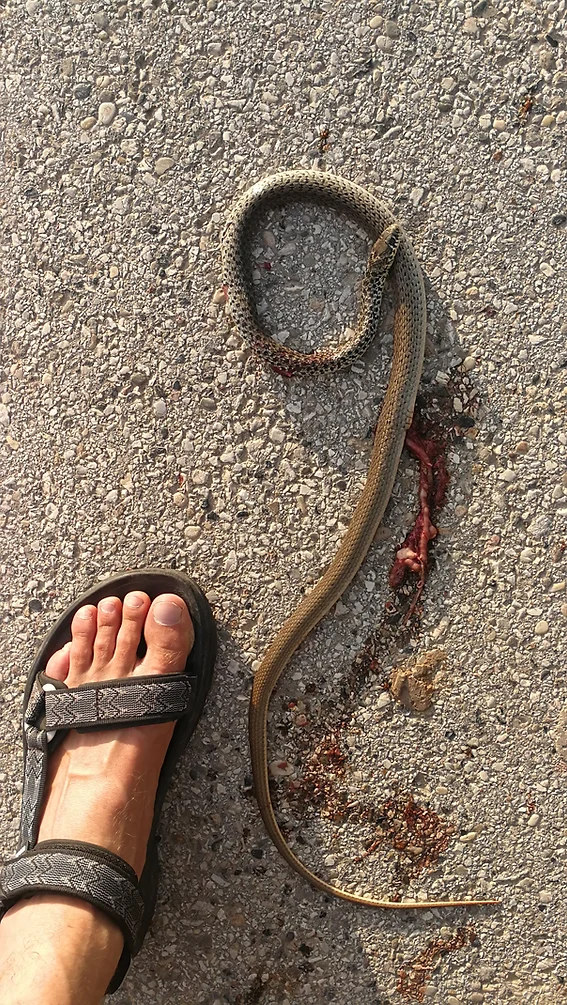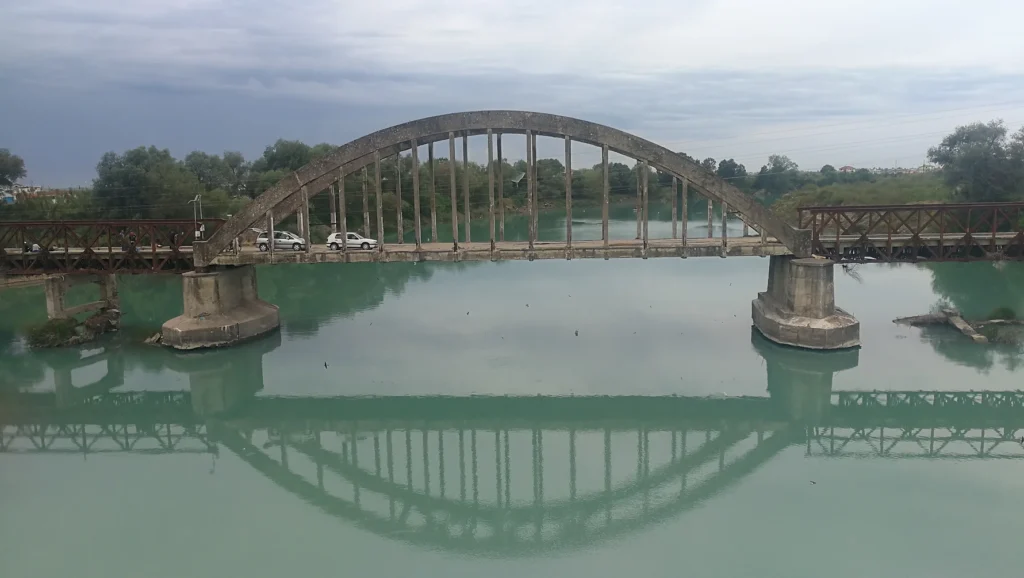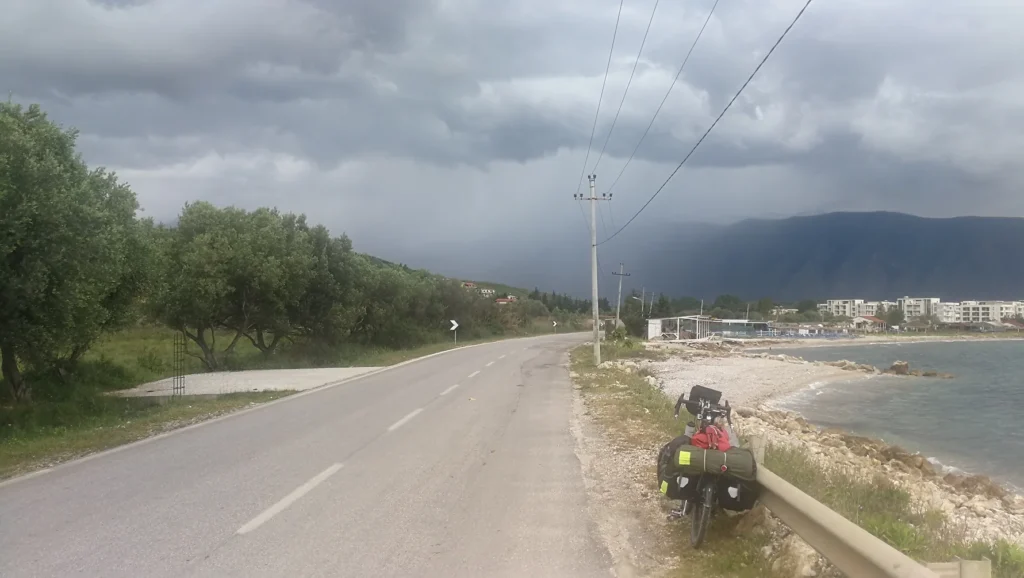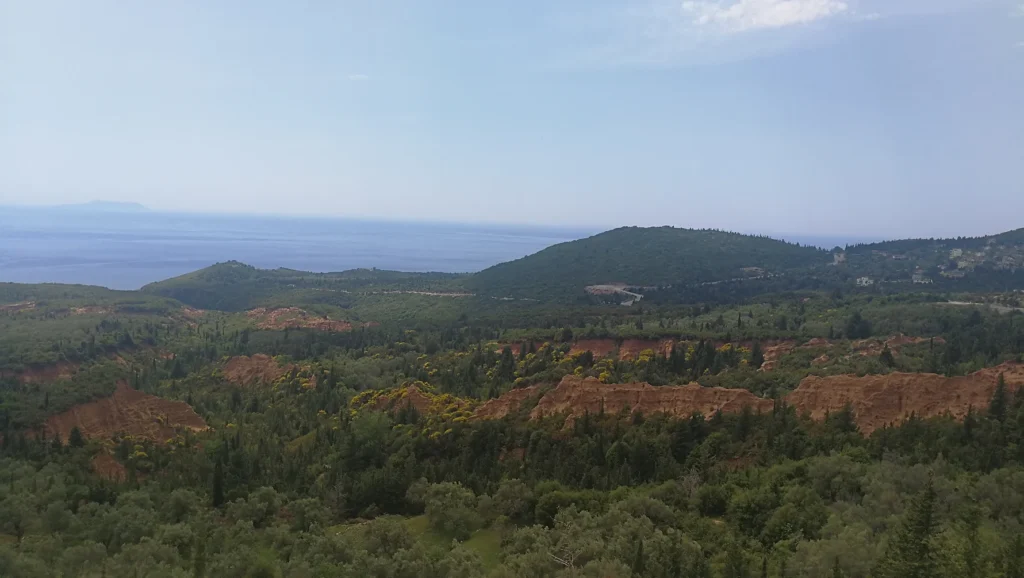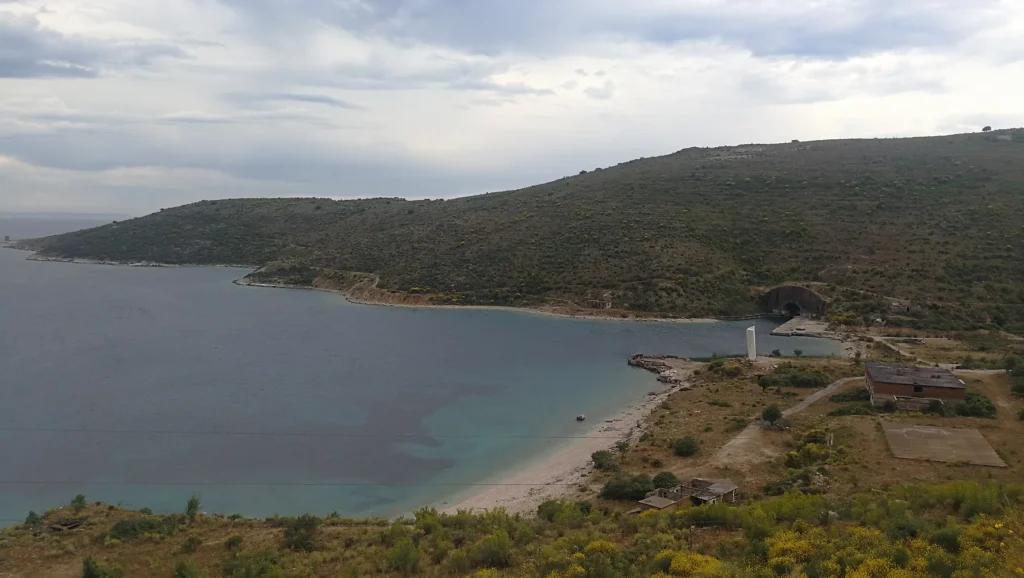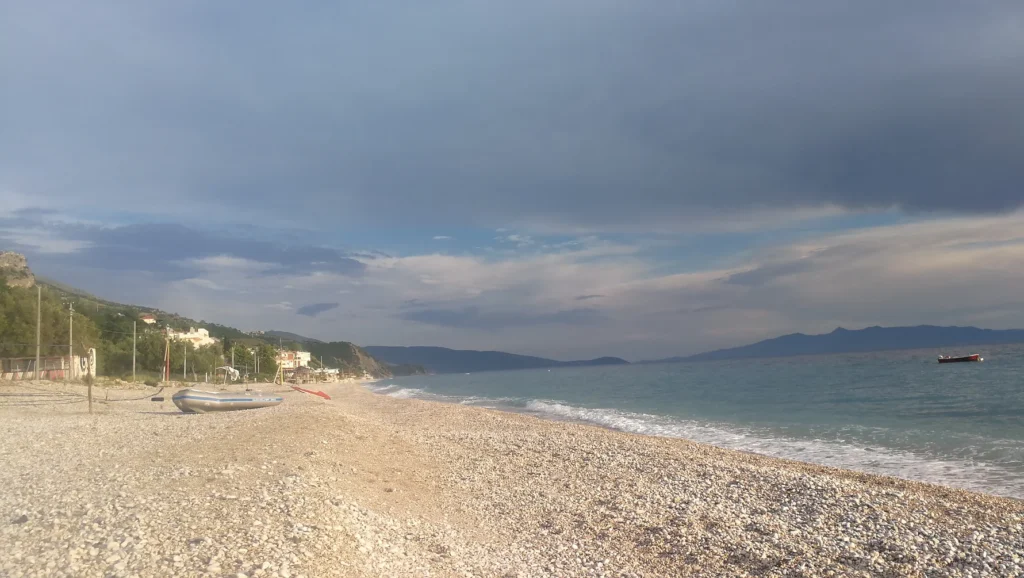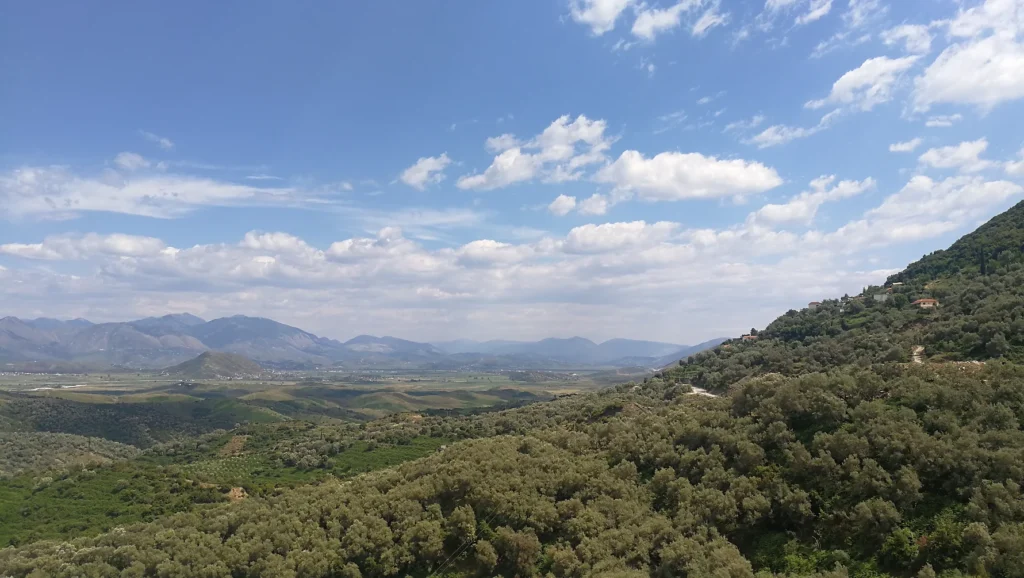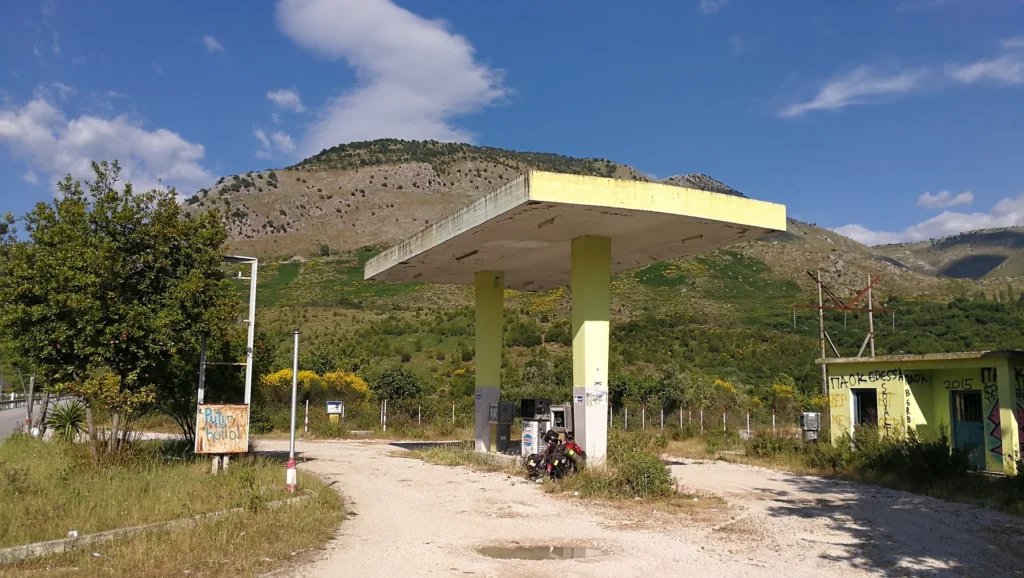Albania — Detachment
And then there it was, the border crossing into Albania.
The Montenegrin border police looked surprised seeing a cyclist. First the checked me in their computer. Then they called Interpol to have them check me as well. However, this is by all means an official international border crossing anyone can take, just rarely used.
Smalltalk with the very friendly Albanian border police: Përshëndetje! Si jeni? (Greetings, how are you?). Speaking some local language always opens doors and brings smiles.
The area of today’s Albania has been inhabited by humans since the Stone Age. In Vashtëmi, in southern Albania, archaeological excavations discovered one of earliest farming sites in Europe dating back around 8500 years.
Entering Albania felt like entering another world – I loved the country from the beginning.
Many civilizations have inhabited Albania over thousands of years but perhaps the most extreme person ruled the country in the 20th century – the communist dictator Enver Hoxha. Under Hoxha’s regime lasting 41 years until his death in 1985, Albania became one of the most controlled and isolated countries of the world earning it the nickname “North Korea of Europe”.
In the 1990s the remaining communist regime collapsed and in 1997 the United Nations send peacekeeping troops as the government had lost control of the country. Today Albania is a flourishing democracy opening up to the world, became a NATO member in 2009, and is actively seeking EU membership.
Along the first kilometers after the border there are countless bunkers, all long given up. Hoxha had launched a massive bunkerization program building an estimated 175,000 bunkers across the country – about 6 bunkers per square kilometer. The bunkerization spread everywhere from beaches to remote mountain areas and consumed a large part of the national budget. However, Hoxha – who despite being a communist saw Albania threatened by the Soviet Union and China (and by pretty much every other country too) – wasn’t a friend of criticism. When his defense minister criticized the bunkerization program he got executed.
Most bunkers were of the type “Qender Zjarri” (firing position) just large enough for 1-2 people. From a military perspective, those bunkers served almost no purpose. Without connecting tunnels and bunker infrastructure today’s military analysts wonder: How would people in the bunkers have received resupplies of food and ammunition? How would they have communicated with each other?
During my time in Albania I considered sleeping in a bunker several times for fun – but inside they are simply too small to sleep comfortably stretched out on the ground.
The SH20 road from Montenegro down to Lake Shkodër used to be challenging even for off-road cars but it got upgraded recently. First there are some gentle uphill kilometers after the border.
Zero traffic, nobody around. I cycled by feel without checking a map. In retrospect I should have cycled into Vermosh, Albania’s northernmost mountain village, but it’s a good reason to come back – I would love to see this area in winter.
I chatted with locals in a small mountain village about how much snow they had in the last winter.
Do you know this experience when you look into people’s eyes and see something profoundly good?
The stretch between Lëpushë and Tamarë was breathtaking. It’s a constant downhill over 24 kilometers in a spectacular highland area … and a 1,100 meter drop in elevation. Most of the time the road winds through steep canyons with huge vertical walls and lush vegetation high up the mountain flanks – truly amazing.
The few people here maintain their traditions. Even high up in the valley wine is cultivated. Fences, houses, and gardens radiate attention to detail and hard work. People wear traditional clothing. And everyone is authentically warm and welcoming, smiling, waving, and giving me friendly thumbs up. Wow!
I got taken away by this downhill dream – before my tour I had read about brake heat buildup on long downhills and here I experienced it for the first time.

A 160 mm disc brake rotor stopping a loaded touring bike heats up considerably on long downhills theoretically up to a point where the brake pads glaze and loose braking power.
After this experience I adjusted my riding style on long downhills by alternating front and rear brake usage (to let each brake cool off some seconds) and by replacing brake dragging with single brake bursts even though the riding gets a bit rough … minor changes. I realized the easiest way is to simply do brake cooling stops enjoying the mountain scenery.
The good that you see in some people’s eyes – where does it come from?
Living close to nature like in the Albanian highlands probably helps but I’m not sure if that’s the decisive factor – in my experience you can encounter the good and evil in people’s eyes and hearts anywhere.
Perhaps it’s primarily a result of emotional integration. Like when people have sufficiently practiced giving compassion to themselves and to others and to their individual emotional biographies – which in turn may work well living close to nature.
Perhaps it’s somehow a community thing. Like when the good is locally woven through people living in a certain area – is there perhaps something like a “collective pendulum” swinging through people’s souls?
Who knows, after the painful, toxic and evil Enver Hoxha dictatorship, perhaps the souls of Albanians today swing towards the good.
In the mountain villages, life made a peaceful impression. Sometimes I met friends on the road:
Other times I met friends on the roadside:
In Tamarë I read a signboard on past Albania travelers. Even though I had entered Albania just 4 hours ago I could already well relate to their experience. This country feels cultivated, traditional, inviting, and overall positive – this country feels like a force for the good.
How can ethics be taught well?
The signboard made me think of how my bike tour started as an ethics professor thinking about values.
If an exemplary value of the Albanian culture is hospitality – where did this value come from? Ok, tradition is an answer. But if this value has been passed on from generation to generation – how did the tradition of teaching this value begin? Did this value somehow form initially out of nothing inside the Albanian ancestor’s consciousness?
Panta Rhei – everything flows.
How do values and traditions flow across generations beyond the life path of an individual human?
In nature, water is flowing – just like you and me are flowing through our consciousness journey of life. In nature, there is a water cycle. What about our human consciousness?
Is there a place where we all come from, a place where we all all go?
Is there a place where everything is one?
I found a great place to sleep my first night in the Albanian mountains: under a bridge some kilometers south of Tamarë.
I felt peaceful, I felt free, I felt myself.
In the morning I first continued my Albanian downhill dream, then faced some uphill serpentines.
The road SH20 got a major upgrade in the last years funded by the EU. Older reports I found online told stories of 4×4 cars needing 8 hour for the northern 30 km in rain but now there is perfect tarmac all the way – the road still smelled new.
In the entire SH20 valley I saw almost no traffic – dream cycling on an empty road. The northern SH20 highland area is a spectacular mountain valley unlike anything I have seen before.
The only other person I saw until noon was a road maintenance man walking down the new road with a shovel. I assume he was clearing it from potentially fallen stones in a serpentine section. He was wearing a blue shirt, had an accurate haircut, and was so polite and educated when we talked that I felt impressed – Albanians are amazing people.
I wondered about the spiritual beliefs of this man. His was probably around 50 years old and thus he must have seen quite a rollercoaster of the public side of religion in Albania.
In 1967 the dictator Hoxha declared Albania the first atheist state of the world and launched a violent campaign to eliminate religion. Within one year all mosques, churches, and other religious institutions in the country had to be closed and the population was forced to quit practicing their faith. This “Albanian cultural revolution” got reversed after the collapse of communism and in the 1990s the rehabilitation of religion was one of the measures taken to stabilize the country.
Today most Albanians are Muslim or Christian but the country has no official religion and Albania’s constitution states explicitly in Article 24 that “Freedom of conscience and of religion is guaranteed“. In 2014 Pope Francis praised Albania for its religious tolerance and said the country is an example for the world.
But what about the internal experience of the man I met on the road – were the spiritual beliefs in his consciousness perhaps influenced by the environment he lived in?
Given the beauty of this land, the vastness of these mountains, the purity of nature, the visible forces forming and decomposing mountain ranges full of biodiversity and life – could this man live in this environment without sometimes feeling a connection to something greater than himself?
In any case, the man’s consciousness just like yours and mine must logically contain some assumptions on the (non)existence of god – whatever they are. Believers of every type will debate the question of god’s existence forever but we all have in common that our consciousness is influenced by our life experiences, including internal things like our feelings and external things like the state of science and the zeitgeist.
Zooming out a couple of centuries shows that humans have always been influenced by science and that after each breakthrough scientific discovery we adapted our dominating world concept. Historically, we started worshiping nature and the elements. Much later, following advances in our physical understanding of the universe, for a geocentric period we believed everything in the universe turned around the earth. Then for a heliocentric period we believed everything turned around the sun. Then our understanding of physics and the universe expanded and evolved to much more complex world concepts.
How will our world concepts evolve in our consciousness when we fly to Mars, progress with quantum physics, and make some of our wildest artificial intelligence dreams a reality?
Writing something about god is tricky given how polarized and politicized “religion” is today.
One can think about order in the universe. Yes, some things are chaotic but given that there is quite some order on the largest and smallest scale of the universe, I wonder where that order comes from. Can so much order coincidentally emerge out of chaos or must there be a coordinating force?
One can look at things as an empirical anthropologist. It seems that on all continents many people have believed in god since pretty much the beginning of humanity. Yes, they could all have been wrong but I wonder why so many people across so many cultures have consistently believed in the existence of something greater than themselves. Can that be a coincidence?
One can think about god from the individual perspective of different human personalities. Are humans differently inclined to accept a force larger than themselves depending on their personality traits?
Perhaps our feelings are central. Perhaps the technologization of our society distracts us from feeling our emotions and from feeling our spirituality.
Perhaps there are as many answers as we are humans on earth and perhaps the answers also change over the course of our individual lifetime. The Albanian National Tourism Agency has a fitting slogan: “Albania – go your own way.“
The serpentines raised the road from 200 meter to 700 meter elevation, then I cycled down to Koplik at sea level to find an ATM and to restock food supplies. The closer I got to Lake Shkodër the more the landscape changed towards a Mediterranean feel.
Koplik is a friendly small town – everyone was smiling and saying hello. Given road construction works and new restaurants and internet cafes, it felt like the town was raising up at the moment.
At the central place is a monument on the 1920 “Koplik war” in which the Albanians successfully defended their northern territory against invading Yugoslav forces with a counterattack.
After getting some Albanian money (Lek) and buying food supplies, I studied onward route options. Should I cycle directly south towards Tirana? The 120 km at flat sea level would be doable this afternoon.
But how would the mountains look like in the valley of the SH21 road? I decided to cycle northeast back into the mountains and over a 1,700 meter pass into Theth National Park.
In Koplik it had 30°C but climbing back into the mountains the air became fresh again.
Mountains have always attracted me, they have something calm, something purifying. They also treat us all equal – mountains don’t care who you are, going up is the same effort for everyone.
On our individual journey into our consciousness, I think a constructive approach to the question of spirituality is to look for common denominators across thinkers and cultures and time. My assumption is that what different humans have consistently experienced and expressed regarding spirituality in their consciousness is statistically more likely to be correct.
For example, the Christian theologian, philosopher and spiritual seeker Meister Eckhart (1260-1328) emphasized the role of detachment:
“I have read many writings of pagan masters, and of the prophets, and of the Old and New Testaments, and have sought earnestly and with all diligence to discover which is the best and highest virtue whereby a man may chiefly and most firmly join himself to God, and whereby a man may become by grace what God is by nature, and whereby a man may come closest to his image when he was in God, wherein there was no difference between him and God, before God made creatures. After a thorough study of these writings I find, as well as my reason can testify or perceive, that only pure detachment surpasses all things.”
Or as another example, the Bhagavad Gita, one of the holy scriptures of Hinduism dating back about 2,200 years, similarly emphasizes the role of detachment:
“One who is not disturbed in mind even amidst the threefold miseries or elated when there is happiness, and who is free from attachment, fear and anger, is called a sage of steady mind.”
Other schools of thought see the role of detachment similar, including Islam (Zuhd), Buddhism (Nekkhamma), and Taoism (Wu wei). The words and exact interpretations differ but in a nutshell people across cultures and time consistently found detachment in their consciousness key on their spiritual journey.
What is the implication for our consciousness exploration? In my perception the central implication is that “words”, being thought or written or read or debated, are not as important as our real and direct consciousness experience without words – what we feel.
Perhaps sometimes, just enjoying the beauty of shadow and light playing together is where we understand our consciousness best.
What’s your perspective on detachment, dear reader?
Many people have expressed that detachment doesn’t feel “cold and distant” but rather “warm and close”. Given that we are all unique, probably everybody makes a different and individual feeling experience with that – I don’t know.
Breathing in, breathing out.
The SH21 valley is broader than the SH20 valley – different feel, but equally amazing. In the beginning of May you already see the sun before 6am and until 8pm at the mountain peaks.
Through the center of valley flows the river Prroni i Thate. Judging from the riverbed it can be torrential in times of snow melt but at the moment it was completely dry.
I pitched camp in Bogë next to a little restaurant and went into my sleeping bag feeling excited. How would Theth National Park tomorrow look like?
In the morning I put on new front brake pads as the old ones had lost braking power. Probably this was unnecessary but I was too inexperienced to really tell the difference and may have been influenced by the brake heat experience yesterday.
I cycled further up the valley towards the pass at 1700 meter. From there it’s a long downhill into Theth National Park – a glacier valley sometimes called the “Chamonix of Albania” given its beauty. My mountaineer heart was excited to see it.
Almost at the pass I noticed slight front wheel play. After changing the brake pads this morning, I must have tightened the wheel a bit too soft or not aligned it completely central. I realigned and retightened the front wheel and heard a sound which I immediately knew would change my day: my front axis screw had broken.
My mistake resulting from over-tightening following my earlier mistake to not take better care of my brakes … I lacked basic bike mechanic skills. This would have been avoidable and I felt stupid.
No beautiful Theth valley today without that screw. I waited for one hour and then hitchhiked back all the way to Koplik and then into Shkodër, assuming that chances to find a replacement screw would there be higher.
The old town of Shkodër is dominated by friendly and chaotic markets offering everything: fish, herbs, vegetables, shoes, and big plastic bags of fresh locally-grown tobacco.
Very friendly locals, everyone was wearing a smile. In retrospect, I feel thankful that my axis screw broke … it taught me something about detachment and brought me closer to the people.
With the help of a determined old gentleman and two teenage boys translating between us, we searched a replacement screw for some hours. We asked the local metal collectors and the fifth one had a screw that was a bit rusty but worked perfectly well (I had to replace my quick-release clamp with a traditional nut but whatever, the bottom-line was the bike rolled again).
In Shkodër, like elsewhere in Albania, I was impressed by the helpfulness, warmheartedness and generosity of the people – Albanians are amazing and their values inspire. I invited my helper team for a soda and they shared many stories from their lives. Ju faleminderit! (thank you)
In the evening I thought about onward route options. Tirana would just be 95 km south cycling along the flat coast. Or should I go back into the mountains? My feeling compass said a clear “yes” so I decided to approach Theth valley again, now from the east via Valbonë. Why give up the first time?
I found a little campsite in downtown Shkodër and the owner connected me with a van driver going to Komani lake the next morning. From there I planned to take a ferry to Fierzë, then cycle up into Valbonë National Park, and from there I could perhaps hike over the mountains into Theth valley (snow permitting).
I bought food for 4 days (I should have brought more) and went to bed.
05:30am pickup – Albanians love Mercedes and it’s on of the most common car brands you see here on the road.
The driver first invited me for an excellent espresso, then we started picking up other passengers along the route.
In Koman, I switched from the van to the small Berisha ferry. So far the plan worked out.
The ferry from Koman to Fierzë takes 3 hours. Most of the time the ferry is going through narrow gorges as “Komani Lake” is actually the river Drin.
From Fierzë I cycled north along the SH22 road towards Valbonë National Park. Until Bujan the road follows the Valbonë river which flows mostly untouched by humans.
Near Bujan some industry structures appeared but nobody around.
From Bujan the remaining 30 km into Valbonë Valley National Park are uphill. In Bajram Curri the road splits into the northbound Valbonë valley road, and the SH22 going to nearby Kosovo.
Bajram Curri was an Albanian freedom fighter who led a guerilla unit during World War I. The town named after him has a large mosque and a pretty laid-back feeling.
The climb up into Valbonë valley offers great mountain views along the entire route.
And then there it was, Valbonë, the end of the road. Valbonë is more a handful of spread out houses than a village which gives the nature in the valley an untouched feeling.
I’m not sure when the season here starts or if there are many people at all coming in summer. During my four days in this valley I probably saw less than 15 people in total.
I found a signpost on transborder hiking through Albania, Kosovo, and Montenegro. The three countries have stitched together a 192 km round trail through sparsely inhabited mountain regions (and coordinate the required border police permits) – how cool can it get?! This trek through one of the last wild areas of Europe must definitely be spectacular.
The transborder trail includes the Valbonë-Theth section I had in mind. Some locals said there was still too much snow to cross it, others said the route was free of snow. Time to find out myself.
Alpine forests with red and green beech trees, a mountain chain waiting to be discovered – this place let my mountaineer heart beat higher.
I camped next to a restaurant where the road ended. Peak Maja Jezercë, with 2,694 meter the highest mountain of the Dinaric Alps, was just 5 km west.
Mountains are good listeners. You can tell them everything and they never get tired to hear what’s on your mind. Or perhaps they are so detached from words they just don’t care what we tell them?
I don’t know about the consciousness of mountains but for humans I think it’s fair to say that nobody really knows how our consciousness works as far as I understand the scientific literature. Perhaps that’s because we are all unique?
But then again there may be structural patterns in our consciousness, things that generalize across humans. And to get started, I would speculate that all humans have a subconsciousness – a “thing” inside us under the surface of our awareness.
Let’s assume for a moment that the human consciousness is simple. Let’s assume that we all have a “conscious part” we are aware of, and a “subconscious part” we aren’t aware of. What would that mean regarding detachment?
In such a simple consciousness structure, I would argue that detachment could have two levels. We could be detached from things like words and concepts in the conscious part of us, or we could be detached from the same things in our subconscious part, or on both levels simultaneously.
I don’t know how the human consciousness works but building on this simple example, I believe with some practice like meditation we all can achieve mental states of a calm mind in our conscious part (“being detached from words”) – but is detachment also possible in our subconsciousness?
We will never know, given that by definition this is something subconscious, but I doubt it. I think even when our conscious mind seems to be perfectly still, we always have thousands of words and concepts simultaneously being present in us under our awareness surface – like in a storage of all our previous life experiences. And I think that’s a good thing.
Our consciousness is probably not as simple as having two levels. And in addition we have not only “words and (word-based) concepts” inside our consciousness, but also feelings. This doesn’t mean that our subconsciousness is less relevant for our consciousness exploration – it just means that in reality it’s probably more complicated.
Is our subconsciousness fluid?
Perhaps our subconsciousness is something we cannot really “grasp”, but rather feel when we sense deeper into our awareness boundary … and into the space beyond.
I asked the mountains but they just said nothing, so I closed my tent and went to sleep.
I left camp at 07:00am and tried to reach Theth valley but turned around. The weather got bad and it would have been too dangerous without grampones and an ice axe.
Never mind, I wanted to be detached from things like “reaching goals” in my physical reality anyways. And spending time in Valbonë valley was definitely worth it.
A local had shown me a video from winter here with 1 meter snow in the area I camped. He also told me stories about the wolves – “no problem”.
Turning around – I think it’s underrated.
Whenever we are in the mountains and turn around, it usually reflects that we have picked a sporty project from the beginning – and that we practice self-care. Of course pushing limits is fun too, I guess there is a risk-taking sweet spot in between.
Turning around is my friend.
And in our consciousness?
I think that most “risks” and “fears” and “hurdles” we encounter on our consciousness exploration are pretty harmless when measured by the physical harm they can inflict on us. Did a feeling you let arise ever bite you in the leg?
On our consciousness exploration we can also pick sporty projects from the beginning – what about finding our true self? But unlike the physical mountains, on our consciousness journey I think we can take much more risks to overcome our deepest fears and don’t really need to worry. What should go wrong? That we “feel” or “think” something unpleasant?
The whole language thing in our consciousness, all those mental concepts around “Who am I?” and “How does my reality function?” – I think it’s normal. We all get born, learn a language, and start thinking in words – so having word-based reality-concepts and attachments to them seems to be our natural state when we start thinking about detachment. But over the course of our lifetime, perhaps words are just a rite of passage, or at least they can be depending on our onward consciousness exploration choices.
What happens when we encounter hurdles on our consciousness exploration and we don’t turn around but decide instead to trust ourself and move forward?
Breathing in, breathing out.
Detachment seems to be an attribute of a final state we may decide to develop into (whatever that means for our subconsciousness), and simultaneously it can be a practice to get there. As a consequence, we probably shouldn’t strive for detachment too fast, or regard detachment too much as a goal in isolation.
Yes, thinkers across cultures and time have expressed that they found detachment key on their spiritual journey – but isn’t detachment more a side-effect of many interwoven consciousness development processes we go through?
Who knows, perhaps there is much to be gained from staying in the “attached thinking space” for quite some time on our path. Like that, when our conscious part is empty, our subconscious part, with all the words and reality-concepts it contains, may be sorted out better and we may therefore have a truly calm mind (instead of just suppressing our thoughts with force).
Let’s look at an example: If there is a god, what are god’s attributes?
We could just skip the thinking and sorting out regarding this question in our consciousness and directly try to brute-force us to have a calm mind detached of thoughts. But if we do that, existential questions may forever linger in our subconsciousness and perhaps they gnaw at us and affect how we feel.
So let’s give this topic a go and run a little thinking loop over it: “If there is a god, what are god’s attributes?” is the question we bring into our conscious awareness
The metaphors differ and monotheists and polytheists have different god concepts but if god exists then generally a key question from a consciousness perspective is where to find god.
In which direction should we listen and feel in our consciousness? To which of our senses should we pay attention? The answers depend on our assumptions regarding god’s attributes … is god something “out there” or something “inside ourself”?
Imagine for a moment that the pantheists are right. Imagine that god is simultaneously everything and everywhere, all matter and energy of the entire universe across space and time combined.
In that case god would be in every cell of your body and in every feeling you have and in every thought you think. God would be simultaneously you and me and the rest of humanity and would basically play with himself through the creation of life and the creation of a partial consciousness for each individual human.
Imagine for a moment that the atheists are right. Imagine that the universe is just a physical system which has created life forms like humans through natural processes somehow emerging in the existence of the universe.
Would there be a difference for our consciousness exploration and the way we live our daily life?
We probably can’t make provable statements about god’s (non)existence. This could be for a variety of reasons as diverse as “we don’t know if god exists” to “language is too limited to make statements on things beyond the boundaries of language”.
But provable statements on god’s (non)existence may not be required to make good life choices on our path. Perhaps all we need to do is to listen inside our consciousness, become receptive inside, and naturally feel ourselves.
Imagine that you and I listen into our consciousness. Imagine that we observe the thoughts in our consciousness and that we feel the emotions arising in our consciousness and that we then act in our life according to what feels right given the overall sensory input we perceive. In that case god may or may not exist (and if god exists it could have any attributes) – we would always make the same confident and clear life choices following our individual feeling compass.
With that conclusion, we can happily let questions like “Is there god?” and “What are god’s attributes?” fade away again into our subconsciousness. But first having gone through this thinking loop, before jumping into detachment, may lead to less existential questions lingering inside us when we then detach … no matter how we answer.
This thinking loop was just an example where “thinking before detaching” may change things inside us. Which thinking loops you go through and how you handle large questions is purely your decision on your individual consciousness journey through life. Go your own way, dear reader!
What feels right to you?
Much rain throughout the last night. Today I relaxed in camp to be strong for cycling on.
Tomorrow I want to cycle towards Tirana via Bajram Curri/Fierzë/Fushë-Arrëz, then perhaps through Qafshtama National Park, depending on the weather.
I descended to Bajram Curri and restocked food, then turned south towards Bujan. From here you can cycle via Tropojë and Qafë Morinë into the Republic of Kosovo (and generally go east towards Istanbul) but I decided to see more of Albania – this country felt amazing.
In Fierzë I chatted for a while with a large group of teenagers, I think they were coming back from school. All super friendly.
From Fierzë I took the SH22 towards Fushë-Arrëz, cycling south of the large Fierzë reservoir.
Brutal stretch along Fierzë reservoir due to simultaneous horizontal and vertical road zig-zag that adds up. Zoomed out on the map the road looks like it goes roughly straight south-east. In reality, a point 10 km ahead equals 30 km cycling with a total of 1,000 m elevation gain.
Hot and humid in the morning, alpine forest in afternoon, rain for dinner. The inner Balkan cycling conditions are truly diverse.
Good day on the bike – time to pitch camp and cook a big dinner.
Life is like cycling in the Balkans. Diverse conditions and much to explore when you just go for it.
The longer I was on this bike tour, the more I realized that trusting my feelings more and living more in the moment worked better than the academic overthinking I had gotten used to in my previous life. And I realized that trusting my feelings more worked well both on the road (creating a relaxed and good cycling experience) and also inside myself – trying to brute-force-think our way deeper into our consciousness isn’t working.
“Soul” – what does the word mean for you?
I know almost nothing about the universe but I find the fact that we can go on a consciousness exploration fucking amazing!!
Think about this for a moment. You don’t have to give up your job and apartment and go on a long adventure to start your consciousness journey – you can start wherever you are in your life by simply listening a little bit more inside yourself how you feel.
I think self-exploration of our consciousness may be the greatest thing we can do in our life – because whatever reality concepts you use to make sense of the world … exploring your own consciousness will make your life experience deeper … way deeper.
In the morning I cycled down to a lower elevation. These mountains really have a lot to offer. The nature looks healthy wherever you go, you practically see zero garbage along the roads, and there is basically no traffic – cycling here on a foggy morning is like an oxygen shower.
In Fushë-Arrëz I stopped for a coffee. Coffee stops are excellent opportunities to chat with locals and get some impressions of their daily lives.
Google a geographic map of the Balkans – which route would you cycle from Berlin to Istanbul?
The Balkans are basically a mountain area everywhere but beyond that you don’t know much before being there on the ground. Is it going to be hot or cold? How is the road pavement? Can I buy food? The one constant thing is that the nature and people are amazing.
Left or right? Easy decision when one option is the longer mountain route.

Riding small roads in Albania means practically zero traffic, bring your food, and friendly locals. Here is the thing with cycling in the inner Balkans, also in Bosnia-and-Herzegovina and Montenegro: a hill 300-500 meter up is common and you might have had seven by the late afternoon.
I felt grateful for the opportunity to be here. I felt grateful to be alive as a biological being cycling through nature – cycling here was truly rewarding.
This consciousness journey you make in your life, dear reader – have you ever asked yourself where it is leading?
We are all making this journey whether we explicitly think about it or not. I don’t want to imply something like “our life is a journey back to god” – that’s for everyone to decide for themselves and I respect atheists equally to believers of any other kind.
But I do think that, as the smallest common denominator of the human condition, it’s fair to say that over the course of our biological life our consciousness develops.
And in my view, it’s also fair to say that between the day we are born and the day we die, our consciousness self-reflection increases – everyone naturally reflects on themselves as part of the human condition.
So that’s all I mean by asking if you have ever asked yourself where your consciousness journey is leading – your natural self-reflection increasing over your biological life.
“Who am I?” is a deep question.
Personally, I believe it’s better answered by listening into our feelings than by thinking. But hey, I’m just a cyclist.
Breathing in, breathing out.
Since leaving Berlin, the longer I was on the road the more I realized that the exact route I cycled didn’t really matter. When you cycle from Berlin to Asia you have – not just metaphorically but as a fact – a million different route combinations available leading to the same distant goal.
And the longer I cycled, the clearer I realized that having a good experience on the bike was anyways more a question of my inner attitude than dependent on the route left or right.
The area south of Fushë-Arrëz was good adventure cycling territory. Some rain, much up-and-down, and increasingly hot and humid with the sun coming out. The nature here has a touch of a rain forest.
I had assumed the stretch southwest of Blinisht on the old road SH30 to be particularly quiet given the parallel new motorway down in the valley. Also this time, the old road over the mountains didn’t disappoint – zero traffic. Whenever there is a new parallel highway you are basically guaranteed that nobody takes the old road over the mountains.
The only people I met this afternoon were shepherds, all super-friendly. At several occasions shepherd dogs came barking at me but when you stop and keep some distance from the sheep and goats you get along well.
Cycling up, cycling down, cycling up, cycling down. The Balkan is a great training in acceptance of external conditions.
A stopped at a roadside memorial on Albania’s fight against the German occupiers in 1944. I felt angry about Germany’s shameful Nazi past. I felt a responsibility to contribute to Albania’s healing. And I felt thankful that today Albania let’s me cycle freely wherever I wanted in this fantastic country – it’s a sign of trust that’s worth a lot.
In the afternoon I cycled by feel, navigating only by the sun position – on some days, just flowing around reality on the bike is super relaxed and fun.
Next time however, I would probably take the turn towards Rreshen (SH34) or the turn towards Ulza Regional Nature Park (SH6) which both would have allowed cycling to Burrel, then through Qafshtama National Park (SH38), and then take Hida Road past Lake Bovilla before sneaking down all the way into Tirana center on a backcountry road while avoiding highway cycling completely.
That had roughly been my plan before, but today I was too dreamy and simply missed both turns. But hey, it doesn’t really matter which route you take anyways in the grand scheme of things.
In the evening I pitched camp in a dry riverbed close to Milot. On the map the river Mat is several hundred meters wide but I didn’t see any water.
Do we have a free will?
We could have a long and complex discussion here based on different assumptions about physics and the beginning of the universe and about god and the nature of our consciousness.
But would such a discussion bring our consciousness expedition forward?
I didn’t know if humans had a free will but my gut feeling said yes being aware that this could just be an illusion in my consciousness. Did it matter?
Let’s imagine that we were sure that humans do not have a free will given that the laws of physics or a pantheistic god or something else would control everything we do. Then what?
Personally, I would live my life exactly the same way as if I was sure to have a free will. In both cases I will make my life choices based on listening to my feelings and then acting according to what feels right inside my consciousness given all the sensory input I perceive.
What about you?
Cycling on highways in Albania is mostly relaxed. Few traffic, respectful drivers – as a cyclist here you can feel safe.
Several times I saw road signs with the entire country displayed.
Cycling on the highway was a different experience than my first eight mountain-dominated days in Albania. Here carrying food is almost unnecessary as excellent espressos and fresh fruits are regularly available directly next to the highway.
Often the super-friendly Albanians didn’t even let me pay. The people here are authentically warm and welcoming, smile a lot, and make you feel good when you chat with them. Përshëndetje! Si jeni? (Greetings! How are you?)
Closer to Tirana there was more traffic on the highway, thus I switched to parallel side roads.
Salt production? But it’s 15 km from the coast, probably it’s something related to mining.
In the evening I checked into Tirana backpacker hostel in the city center – a place full of love.
I stayed four nights in the hostel, explored the city, and relaxed with other travelers.
Tirana is surrounded by mountains, has a Mediterranean touch, and felt young, cool, vibrant, and alive. This city has meanwhile been voted European Youth Capital 2022.
The locals love their coffee culture and Albania is one of the countries worldwide with the most coffee houses, bars, and restaurants per capita – this is a place to be social.
While I generally paused my biketouring mindset here, I went through all my equipment and critically re-evaluated what I really needed having realized that less equipment makes you faster, particularly in the mountains.
After having already left equipment behind in Budapest and having send home a package from Croatia, I now send home another package from Albania. Everything you possess also possesses you.
And in our consciousness?
Perhaps a beginner’s mind, an attention towards ourself without the assumption that we are already experts, lets us discover the most about who we truly are – letting for example our emotions arise always requires a little openness to change.
But a beginner’s mind still leaves the question how much equipment we travel with in our consciousness, as long as our goal is not something like “complete detachment”. So how do we calibrate this? And which consciousness equipment do we take?
On a bike tour, equipment decisions basically result from the level of trust you have in yourself and from your touring style. If you think you will be fine with less stuff, leave it behind.
On our consciousness journey, perhaps risk-calibration can work similarly. Also here, the individually right decision between being risk-friendly and risk-adverse results from “where” you want to go, and “how”.
What is your willingness to take risks inside yourself on your consciousness journey?
I believe answering this question is constructive for everyone.
On the one side, all our small and large decisions regarding which consciousness exploration risks we take form our character, form who we become as an individual, and thereby ultimately shape our entire life journey.
On the other side, integrating our emotions is key to live healthy and happy but in order to do this we need to trust ourselves sufficiently to “take the risk” to let our feelings arise.
Trusting ourself, accepting consciousness risks with a beginner’s mind … I think that stuff is exactly what we all need to live deeper.
But I think there is a fundamental difference between a bike tour and a consciousness journey: on a bike tour you can adjust your equipment instantly, but consciousness adjustments generally require commitment and repetition.
I don’t believe that we find deeper answers in our consciousness quickly. I don’t believe that we form our character and who we are as an individual quickly. I do believe that a central ingredient in any consciousness exploration is endurance as deeper self-reflection takes time.
The world doesn’t lack proven wisdom about consciousness self-exploration and about how to live a good life – the world lacks focus and continuity in implementation. The martial artist Bruce Lee framed the power of focus and continuity this way:
“I fear not the man who has practiced 10,000 kicks once, but I fear the man who has practiced one kick 10,000 times.”
In my view, living deeper on our consciousness journey works the same … whatever you believe in.
In the morning I bought gasoline for my stove and then left Tirana on the old road (SH3) towards Elbasan. Also this time the old mountain route was free of traffic given the parallel new highway down in the valley.
South of Mushqeta the rocks looked like old lava but I’m not sure if it was.
On this stretch I saw locals collecting wild flowers in the hills. Perhaps for tea?
Half-way between Tirana and Elbasan is a small mountain pass – 650 meter elevation cycled up before even the first espresso.
Next to the pass is a memorial board on Bilal Agalliu who won the Tour of Albania 11 times.
11?! Bilal, I bow with respect and admiration to your sportsmanship.
Near the pass I saw the first turtle of my tour. Funny that she was in a hot and dry area at one of the highest elevations points in the region.
The turtle I helped over the curbstone but for others it was to late to help.
After a downhill racing stretch, interrupted by an excellent espresso with a view over the valley, in Elbasan I turned southwest following the small SH58 countryside road towards Belsh.
The landscape changed from rocky and dry into a green agricultural region. I saw a couple of busy farmers on the fields waving a friendly greeting as a cycled by.
In this area there were surprisingly many overrun snakes on the road despite the lack of traffic. But then again the nature here made a particularly healthy impression full of wildflowers and lakes, thus perhaps there are just many snakes living here – which I find fantastic.
In the evening I camped next to a freshly mown field with an intense smell of herbs and flowers. Thousands of light-emitting bugs at night – fat ones with a slowly on-off pulsating light emission while flying.
So if we decide to live deeper and we are committed to practice with endurance like Bruce Lee has practiced one kick 10,000 times – what exactly should we be practicing?
For example, should our goal be to have “worked through” our emotional biography, or should we not set such a goal at all and “just be” as another form of practice?
I don’t believe there is a linear path. And I don’t think that describing our path in words is anywhere near important as being and feeling yourself in the now … words don’t really matter.
But then again if we don’t think and express and exchange ideas on our path in words, we have no conversation at all on things making life deep and we would skip the opportunity to get inspiration from others – directly jumping to a consciousness state of “complete detachment” seems a bit extreme. I think we all feel when ideas by others resonante inside us.
Like countless humans across cultures and time have expressed before me, I personally also believe that practicing love in all its dimensions is a powerful guideline to live deeper and to generally live life well. But such a statement would not mean much without a closer reflection on the meaning of “practicing” and “love”.
In the book “The Art of Loving”, the philosopher, sociologist, and psychoanalyst Erich Fromm discusses various aspects of practicing love. He frames love as an answer to our human condition and develops a theory of love by analyzing different kinds of love – such as love between parents and children, self-love, love for fellow humans, erotic love, and (optional) love in the realm of spirituality.
In my view, the most pragmatic part of this book is the final chapter on “The Practice of Love” where he writes:
“Having dealt with the theoretical aspect of the art of loving, we now are confronted with a much more difficult problem, that of the practice of the art of loving. Can anything be learned about the practice of an art, except by practicing it? The difficulty of the problem is enhanced by the fact that most people today, hence many readers of this book, expect to be given prescriptions of “how to do it yourself”, and that means in our case to be taught how to love. I am afraid that anyone who approaches this last chapter in this spirit will be gravely disappointed. To love is a personal experience which everyone can only have by and for himself.”
He then argues that we must learn many connected skills to master the art of loving, such as discipline, concentration, patience, giving importance to what one is doing, being sensitive to oneself and others, overcoming one’s own narcissism, having courage, having faith in oneself and others, and practicing those skills in all aspects of our everyday life – an analysis he keeps secular without linking it to god’s existence.
Breathing in, breathing out.
In the morning I entered Vjosë-Nartë Delta Protected Area – a massive river delta north of Vlorë.
The Vjosë river is Europe’s last big wild river (outside Russia) flowing untamed over its entire course of 270 km. What makes this river additionally special is that almost all it’s subsidiary rivers also flow freely and naturally – creating a unique river network bursting with life.
This river touched me. The last wild river in Europe? That hurts.
Over the last 50 years, the average population size of vertebrate wildlife worldwide (mammals, fish, birds, amphibians, reptiles) has declined 69%.
Given that humans are part of nature and that biodiversity ensures our survival: how do we balance goals in our society?
Perhaps we feel the answer inside us when we listen.
The closer I cycled towards the southern end of the Bay of Vlorë, the more a thunderstorm formed right there. In Orikum, a city mentioned already 2,600 years ago by Greek writers and later conquered by the Roman emperor Julius Caesar, I turned left cycling into the eye of the storm.
After Orikum the SH8 road climbs from sea level to 1,000 meter elevation within 15 kilometers – a constant 6.6% incline keeping you warm as a cyclist in the rain.
The road tops out next to Mount Çika which is with 2,000 meter the highest peak in the Ceraunian Mountains. In Albanian those mountains are “Malet e Vetëtimës” (mountains of lightning) and already the ancient Greek called them “thunder-split peaks”.
Topographically, I understand why these mountains always had a reputation for thunderstorms. The valley south of Orikum has steep vertical mountain ridges on both sides and is also becomes increasingly narrow thus the clouds pressed down south from the Bay of Vlorë get channeled into one point where the energy gets released.
In the evening the weather changed to dense fog, then in the last daylight hour the sky cleared up.
Near the top the road goes through Llogara National Park with impressively large trees – I think there is an own micro-climate.
Cycling through this forest full of fog in perfect silence after the thunderstorm felt like being in a dream. Perhaps it was? Who knows how our consciousness works …
I pitched camp right at Llogara pass. In retrospect I should have climbed Mount Çika early in the morning to see the sunrise but that idea only occured to me afterwards.
Time to cook a big dinner and enjoy the sunset.
Let’s assume for a moment that “practicing love in all its dimensions” is our goal. Is this something we “do”?
Perhaps the human condition is a game of finding balance across multiple dimensions. Balance between our feelings and thinking. Balance between our consciousness and subconsciousness. Balance between ourself and others. Balance between “actively doing” and “passively letting arise”.
Regarding all those balances, we seem to be free to focus our attention on the two poles and how they interact. And then we can lean into a life direction that feels right … like a good calibration. But what about the “passively letting arise” part of our life – how does that happen at the edge of our subconsciousness?
One the one side, there is an active part of practicing, skills everyone can decide to develop and then do repeatedly.
On the other side, there is a passive part of practicing, the opposite of training a specific skill like “acceptance”. It’s the part of letting go and just listening and feeling into our consciousness.
I think the “passively letting arise” part is powerful no matter your world view. You can live with any assumptions on the spiritual part of your reality – passively letting arise always means you give yourself a chance to discover deeper things inside yourself.
And isn’t that what attracts you and me on our consciousness journey forward? Isn’t learning more about “who we really are” what we all want deep inside, dear reader?
In the morning I bought honey from a lovely lady at a honey booth next to Mount Çika.
Here Italy is just 90 km away – given that the lady’s honey booth was at 1,000 meter elevation and given that the visible horizon distance on the Adriatic Sea should be roughly (observer height*2*earth radius)^0.5 or about 113 km, the visible landmass on the horizon was probably Italy.
In 2011 the endurance athlete Massimo Voltolina completed a 85‑kilometer solo swim from Italy to Albania in under 24 hours in Force 4 conditions on the Beaufort wind force scale (meaning waves up to 1-2 meter). Imagine the intensity of the nature experience and the feeling of freedom he must have had during his swim … respect!
I would be very interested to learn what Massimo’s consciousness did during his time out there. I’m just a cyclist and I don’t know much about the human consciousness … but I know that practicing sports and philosophy is a great combination.
Like racing downhill while letting things arise.
In a sharp serpentine turn near the pass, I stopped at a viewpoint with a spectacular view over the Strait of Otranto right where the Adriatic Sea and the Ionian Sea kiss. What a well chosen design … apparently it’s also a popular paragliding starting point.
The mountains and the sea – where they touch always feels special.
Between Dhërmi and Himarë the Albanian coast line is rugged with deep canyons, including Gjipe Canyon and Vuno Canyon – from the road I saw many more than those two indicated on maps. Imagine the intensity of the nature experience and the feeling of freedom you can find down there in the canyons when you go exploring!
Himarë, a Mediterranean village with a large Greek population, welcomed me with a thunderstorm.
In the afternoon I cycled in the Bay of Porto Palermo which is exceptionally rich in history. The bay is home of an ancient fortress build 200 years ago by Ali Pasha of Ioannina, an Albanian ruler famous for his cultural influence as well as for his cruelty.
Enver Hoxha build a submarine bunker in this bay – the 800 meter long tunnel bunker was able to hold four Whiskey class attack submarines. I don’t know if this is related but Hoxha also seized four submarines from the Soviet Union when pulling out of the Warsaw Pact in 1961. Today, however, the submarines rot away at Pashaliman Naval Base south of Vlorë.
The coastline here was full of a plant I haven’t seen before. But then again somehow it looked familiar – do you know what it is?
In the evening I left the SH8 road and cycled along the sleepy Qazim Pali beach. Somehow in Albania I always felt home.
The beach was great but I couldn’t find a good camp spot and decided to stay in a cheap hotel.
Who are you really, dear reader?
I think you are a curious person. I think you also want to find out more about who you as you are reading this.
We all seem to understand only a small fraction of our reality. Perhaps we simply have to accept that we exist as tiny biological beings in a large universe which is a big mystery.
But what if we really want to know?
What if we want to feel deeper into our consciousness and we commit to practicing whatever it takes to get there – what should we be practicing?
I think we all find our individual answer when we simply live our daily life following our natural feeling compass – when we simply lean into the life direction that feels right and authentic.
What happens when “detachment” becomes this life direction?
I don’t know how our subconsciousness works but I believe we always stay ourself somehow and that this is a good thing. Perhaps the deepest practice is finding a balance between detachment and all the “conceptual things” in our word-based cognition – transforming forward beyond the “I” while taking ourself along the ride with a hug.
I’m just a cyclist but to me it seems that the stuff happening at the edge of our subconsciousness is powerful and that the underlying force of change – however you conceptualize it in your world model – is not something external, is not something “out there” … but is rather a core part of ourself.
By the act of existing in the human condition, we all seem to have inseparably both a certain power and a certain powerlessness in our consciousness … which makes the human condition seem overall fair.
How much trust do you have when you feel into the unknown? What should go wrong?
Breathing in, breathing out.
In the morning I cycled further along Qazim Pali beach but soon regretted it when I had to push up my bike up a steep gravel path back to the SH8 road.
Pretty hot, for the first time the navigation screen on my handlebar bag stopped functioning saying “device needs to cool down”. Imagine the level of courage our fellow human brothers and sisters had cycling around the world 100 years ago without navigation devices or detailed maps. That’s an inspiration of trusting oneself to venture out deep into the unknown!
I soon reached Piqeras, birthplace of the Albanian national hero Vasil Laçi who tried to assassinate high-ranking fascists after the occupation of Albania by fascist Italy.
Sleepy coastal villages. Lukovë once got attacked by Ali Pasha of Ioannina who massacred inhabitants of the region but today the village looked pretty chill.

I can honestly say that I liked every single village I cycled through in Albania – including Shën Vasil where olive oil is produced since hundreds of years. Albania has an estimated 9 million olive trees of which some are older than 1,000 years.
From the mountains to the sea, Albania feels like a country with a healthy ecosystem full of wildlife. Albania is home for various kinds of land-dwelling turtles, aquatic turtles (rivers, lakes), and sea turtles (Adriatic Sea).
In Sarandë, know for its deep blue coastal waters, I turned away from the Ionian Sea and cycled east towards Greece. I had an encounter with an aggressive dog but he was just taking his guarding job a bit too seriously and probably wasn’t used to cyclists – overall we got along well.
Mesopotam in Albania, just like Mesopotamia in Iraq, lays between two rivers. The mountains in this area rise up to 1,600 meter elevation and look spectacular with the bright yellow Ginster.
Very relaxed cycling stretch, almost no traffic.
In the afternoon I did a little side tour from the SH99 road to visit the Blue Eye. It’s a natural spring where 18,000 liter of water per second stream out of a deep vertical hole.
Many divers have tried to reach the bottom but the water pressure makes it challenging and the deepest point divers have reached was 50 meters. When you look down from the edge you can see quite deep into the crystal clear water – I can confirm this water is ice-cold … I liked it.
In the evening I cycled over a mountain pass into Gjirokastër county while eating cherries I had gotten from locals on the roadside. This was dream cycling – I felt free, I felt happy.
Gjirokastër was the birthplace of the Albanian dictator Enver Hoxha. Which influences may have shaped the life path of this sociopathic madman? Did Enver self-reflect on his consciousness while he developed into an exceptionally paranoid executioner ruining his country?
In 1908 when Enver was born, Albania belonged to the Ottoman Empire. His father was an Imam but he was closer with his uncle who was the mayor of Gjirokastër and a radical atheist.
He began studying botany in the south of France but lost his Albanian state scholarship for neglecting his studies. He then went to Paris where he spent time with communist thinkers, and after his return to Albania he worked in low-key jobs – including a position as a contract teacher at a high-school where Enver taught “moral education”.
During World War II he joined the resistance and the Communist Party where he maneuvered himself to the party leadership. In the chaotic post-war years he strengthened his position and unfolded both his potential for cruelty and for economic and political dilettantism.
He ruled Albania for over 40 years and made it one of the most isolated countries even breaking ties with communist Yugoslavia, the USSR and China. By the time Enver died in 1985 he had also made Albania the third poorest country worldwide and while the population was close to starving, the party leadership lived in luxury.
Among his key strengths were executions of about 6,000 people while jailing and forcing into exile almost 100,000 people. He systematically executed opponents but also former allies and supporters, war heroes, several prime ministers, all of his minister of the interior (except for one), and his own brother-in-law.
Being a sceptic of aristocrats, he killed them. When farmers didn’t fully participate in the expropriation of their land, he killed them.
Being a sceptic of religion, he declared Albania the first atheist state of the world, demolished or converted all churches and mosques in the country, and killed most clerics.
Being a sceptic of intellectuals, he killed many or send them to forced labor camps. He build a group of political leaders around him who mostly only had a high-school education.
Not just internationally but also within Albania he hermetically sealed off himself and his leadership circle from the outside world. When Enver died, he had not been outside Albania for 24 years.
The parallel reality he constructed was so extensive that information about Albania’s real development and contradictions to his opinion hardly reached him … also because delivering such news to him could quickly cost the messenger his life in a summary execution. When Mother Teresa asked for his permission to visit Albania to see her old mother one more time, Enver declined assuming she was a foreign agent.
He stood out even among other dictators with an extreme personality cult and a systematic rewriting of history books. For example, he portrayed himself as the central figure in both the Albanian resistance and the foundation of the Communist Party – lies few could challenge given that not one of his early communist comrades survived his terror regime.
He published 13 volumes of distorted memoirs which became mandatory reading in schools. He portrayed himself as the loving father of the nation and liked to be called “Uncle Enver” or “Father Enver”.
He was never held accountable for his cruelties and died as a free man in power.
Enver lived just around the corner. I wondered if he ever stopped on this road to admire the beauty of the rock formations. As a sociopath, perhaps he didn’t listen much to his feelings but on this mountain pass he could have at least wondered about plate tectonics and geology.
Why are there people like Enver in this world?
On the level of an individual, there are explanations around psychology and neuroscience. Some people have neurological disabilities such as brain tumors, sometimes from birth, sometimes acquired through traumas or infections.
Other people have had complicated childhoods – a well-researched biography on Enver (Enver Hoxha: The Iron Fist of Albania by Blendi Fevziu) includes stories of classmates laughing about him in highschool who were years later executed when Enver ruled the country. But whether he was bullied remains speculation and the fact that he executed someone was nothing special.
On a situational level, crime opportunity theories argue that crimes happen when disposition and willingness for crimes meet opportunity – and being a totalitarian dictator without any supervision is the perfect opportunity for anything to unfold.
On a political party level, things may spiral out of control for various reasons. There are fascinating organizational theories analyzing situations where things are done without anyone planning or wanting them. For example, in large organizations people working on lower levels may not have an overview of the overall situation, while people on higher levels may not sufficiently know the details on the ground – and as a consequence, organizations may bizarrely act without anyone in true control.
We could think about the question why there are Enver’s in this world with many more different perspectives. Perhaps the largest frame of analysis is the question of god and his attributes.
Assumptions about spirituality and atheism are different for every human. So if we ask why there are people like Enver in this world, people doing things most feeling humans would classify as “evil”, the answer must be found by each of us individually – together with our decision to which degree we give people like Enver contra in our daily life.
It stands out today how exceptionally warm and positive the people are in Albania – people here are beautiful inside which you see whenever you look into their eyes.
Letting unconditional love grow inside us by leaning into a life direction that feels right and by practicing love in all its dimensions – I believe it’s empowering and that we all can unleash it in our daily life. In a way, I think we all already do.
Perhaps our consciousness is like a garden that we cultivate over time. When we sow consciousness seeds of plants we want to grow, and give them nurture and water, and work on getting rid of unwanted weeds, and when we continue our consciousness gardening project when thunderstorms create havoc, and when we continuously feel in which direction our plants are growing – then our consciousness garden probably grows naturally into something that brings a deep smile to our weather-tanned gardener face, something that we like and we are proud of: our true self.
External things, internal things, detachment … breathing in, breathing out – kind of goes well together.
At night I saw the Milky Way with its 100 billion stars. Around my tent I saw light-emitting bugs and here, unlike the pulsating ones I saw some nights before, they had a small constant light.
Last night I had camped on the stones of a long abandoned house and in the morning the view over the valley at sunrise was magic. See you again Albania – Shihemi përsëri!
Albania was amazing in so many ways – this was the first country where I thought about stopping my bike tour and staying long-term. Living in Tirana for a while? Living in a mountain hut in the Albanian highlands for a while? Working on my ethics book?
No, East Asia was silently calling my name and I felt motivated to find more adventures on the road and inside myself.
And this going deeper thing … I realized it’s kind of fun.
Albania, declared the world’s first atheistic state during a dictatorship and today praised for religious tolerance – thank you for the impulses on spirituality and detachment.



